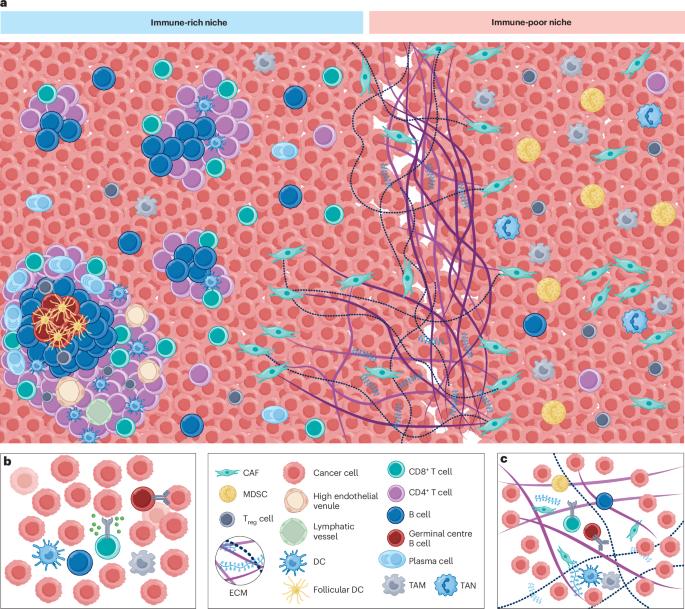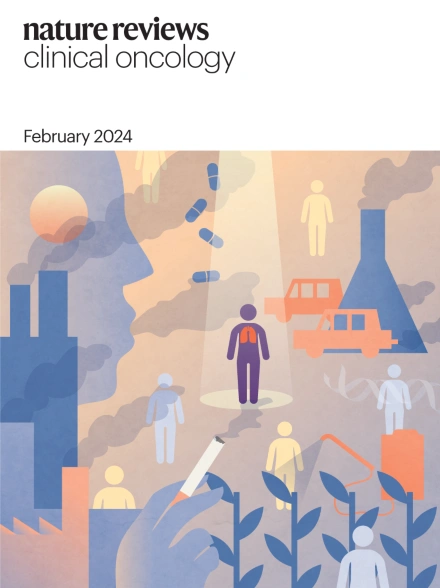非小细胞肺癌进展和治疗反应中的肿瘤和微环境串扰
IF 82.2
1区 医学
Q1 ONCOLOGY
引用次数: 0
摘要
在靶向药物和免疫疗法发展的推动下,非小细胞肺癌(NSCLC)的治疗前景正在迅速发展。尽管取得了这一进展,但一些患者对治疗的反应不佳,这突出了对新治疗策略的需求。在过去的十年中,肿瘤微环境(tumor microenvironment, TME)在NSCLC进展、转移传播和治疗反应中的重要作用越来越明显。了解TME的复杂性及其与NSCLC的相互作用可以推动改进当前的治疗方式,克服耐药性并开发新的治疗方法,最终改善患者的预后。在这篇综述中,我们提供了NSCLC TME的全面观点,研究了其组成部分,并强调了以肿瘤巢内和周围的空间壁龛为特征的不同原型,这些空间壁龛形成了复杂的社区。接下来,我们将探讨这些成分之间的相互作用,重点关注炎症和免疫抑制如何影响NSCLC TME的动态。我们还讨论了与患者相关的因素,如年龄、性别和健康差异,对NSCLC-TME相声的新影响。最后,我们讨论了各种治疗策略如何与非小细胞肺癌的TME相互作用并受其影响。总之,我们强调这些因素的相互联系,以及它们如何影响治疗结果和肿瘤进展。本文章由计算机程序翻译,如有差异,请以英文原文为准。


Tumour and microenvironment crosstalk in NSCLC progression and response to therapy
The treatment landscape of non-small-cell lung cancer (NSCLC) is evolving rapidly, driven by advances in the development of targeted agents and immunotherapies. Despite this progress, some patients have suboptimal responses to treatment, highlighting the need for new therapeutic strategies. In the past decade, the important role of the tumour microenvironment (TME) in NSCLC progression, metastatic dissemination and response to treatment has become increasingly evident. Understanding the complexity of the TME and its interactions with NSCLC can propel efforts to improve current treatment modalities, overcome resistance and develop new treatments, which will ultimately improve the outcomes of patients. In this Review, we provide a comprehensive view of the NSCLC TME, examining its components and highlighting distinct archetypes characterized by spatial niches within and surrounding tumour nests, which form complex neighbourhoods. Next, we explore the interactions within these components, focusing on how inflammation and immunosuppression shape the dynamics of the NSCLC TME. We also address the emerging influences of patient-related factors, such as ageing, sex and health disparities, on the NSCLC–TME crosstalk. Finally, we discuss how various therapeutic strategies interact with and are influenced by the TME in NSCLC. Overall, we emphasize the interconnectedness of these elements and how they influence therapeutic outcomes and tumour progression. Despite advances in drug development, some patients with non-small-cell lung cancer (NSCLC) have suboptimal responses to treatment. The authors of this Review provide an overview of the complexity of the tumour microenvironment in NSCLC, including the influence of patient-related factors, such as ageing, sex and health disparities, on the cancer–TME crosstalk, and discuss how various therapeutic strategies interact with and are influenced by the TME in NSCLC.
求助全文
通过发布文献求助,成功后即可免费获取论文全文。
去求助
来源期刊
CiteScore
99.40
自引率
0.40%
发文量
114
审稿时长
6-12 weeks
期刊介绍:
Nature Reviews publishes clinical content authored by internationally renowned clinical academics and researchers, catering to readers in the medical sciences at postgraduate levels and beyond. Although targeted at practicing doctors, researchers, and academics within specific specialties, the aim is to ensure accessibility for readers across various medical disciplines. The journal features in-depth Reviews offering authoritative and current information, contextualizing topics within the history and development of a field. Perspectives, News & Views articles, and the Research Highlights section provide topical discussions, opinions, and filtered primary research from diverse medical journals.

 求助内容:
求助内容: 应助结果提醒方式:
应助结果提醒方式:


